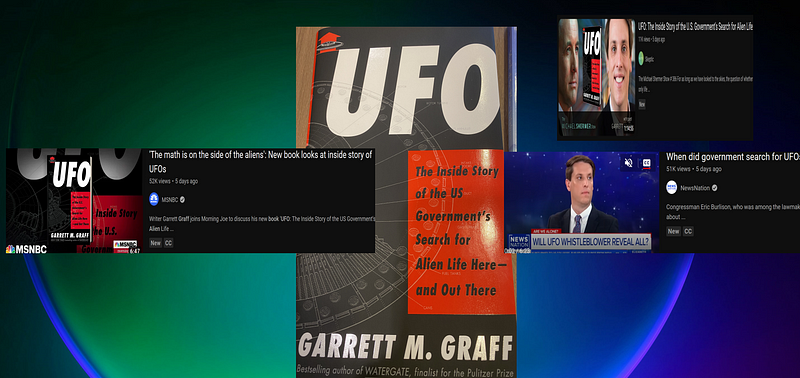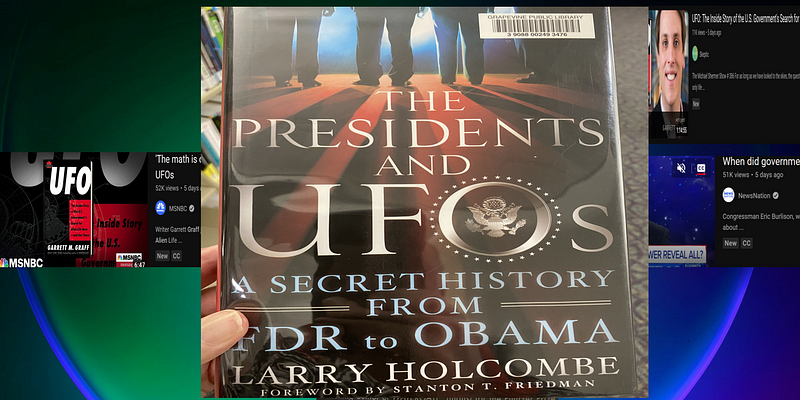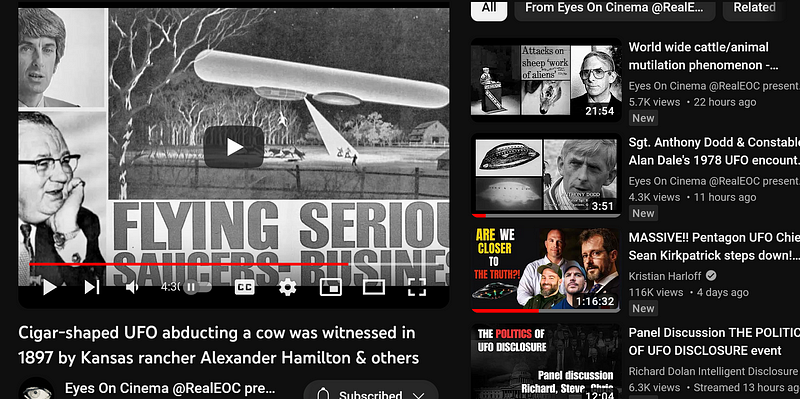# Analyzing Graff's UFO Insights: A Critical Review
Written on
Chapter 1: The Overview of Graff's UFO Contributions
For those seeking a historical perspective on UFOs, Garrett M. Graff’s book offers a foundational overview. However, for fresh insights, it's advisable to turn to more experienced voices like George Knapp.
If you’re a newcomer to the UFO phenomenon and desire a straightforward summary, Graff's "UFO: The Inside Story of the US Government’s Search for Alien Life Here — and Out There" serves that purpose. This work is indispensable for anyone involved in UFO studies, as it encapsulates essential knowledge that journalists covering UFO topics should already possess. Unfortunately, the book does not provide any groundbreaking revelations. It appears to be an attempt by another journalist to capitalize on the UFO narrative, despite the fact that established figures like Knapp, Ross Coulthart, Bryce Zabel, and Jimmy Church possess greater expertise on the subject.

Graff’s work highlights a governmental conspiracy surrounding UFOs—though it lacks malicious intent and instead reflects a fear of incompetence. It seems to be a strategy to garner governmental sympathy while distracting from decades of civilian mistreatment, including the shutdown of discussions on UFOs, the manipulation of the public, and the misallocation of trillions in taxpayer funds. If the phenomenon has roots that predate World War II, this suggests a more extensive conspiracy than is commonly understood, potentially linked to global conflicts and the arms race. In terms of new revelations, Graff's book falls short; Leslie Kean’s 2017 article, “Glowing Auras and ‘Black Money’: The Pentagon’s Mysterious U.F.O. Program,” offers far more substantial insights into the transition of conspiracy theories into established facts.
Despite Graff’s impressive background as a journalist, one might question why his investigative skills have only now uncovered the "mystery." If he aims to position himself as an authority in this field, his book reads more like an introductory chapter to a larger narrative on UFOs. The complexities of this history are far too vast to be encapsulated in a single volume.
While I appreciate Graff's effort, the significance of this topic—especially the reality of extraterrestrial life—should be more widely discussed among journalists and the public. This book, while timely, ultimately misses the mark. The mystery surrounding UFOs extends back to the 1800s, and it raises questions about how a journalist from Australia, Ross Coulthart, managed to uncover this story before an American did. Graff's competence is evident, but if this is an "inside" account, why were none of his sources willing to discuss it sooner? The pressing question remains: Why now? If this is indeed an exclusive report, its superficial historical overview may serve as a distraction from more pressing realities or even act as a prelude to forthcoming disclosures.
For a more comprehensive review of UFOs in the context of presidential history, I would recommend seeking out alternative sources, perhaps even visiting a library for additional insights.

Chapter 2: Contextualizing Graff’s Work
While Graff's book emerged in a landscape crowded with UFO literature, it notably does not reference "The Presidents and the UFOs," published in 2015. Although it’s understandable given the sheer volume of UFO-related texts, Graff’s compilation seems to be a rehash of previously established ideas rather than a fresh contribution.
One could argue that Graff serves as a conduit for governmental narratives, reminiscent of Shakespeare's "out, damned spot." His attempt at providing an inside story ultimately lacks substance. For instance, the Texas Aurora incident from 1897 and the lesser-known cattle mutilation cases from the same year highlight that UFO sightings and experiences have been documented for far longer than most realize.

The narrative of a cigar-shaped UFO abducting livestock, as reported by Kansas rancher Alexander Hamilton in 1897, underscores the long-standing history of UFO encounters. This is not to be confused with the founding father, but rather an example of how deeply entrenched UFO lore is in American history.
From the Romans to medieval artists, there have been records of UFO sightings throughout history, suggesting that this phenomenon has long been part of human experience. Graff’s enthusiasm for his book may stem from a belief that he has uncovered something novel, yet he seems unaware of the many who have ventured into this territory before him.
Conclusion: A Mixed Review
Would I endorse this book? Not for those well-versed in UFO studies. It may frustrate seasoned UFOlogists, not due to its content, but because it arrives too late and exhibits excessive sympathy for agencies that should be more transparent with the public. A friend of mine, who has contributed significantly to the discourse around UFOs, would likely find little value in Graff's work. Perhaps it could serve as a gift for someone with a casual interest in the subject, but it does not offer new perspectives.
There’s an urgent need for journalists like Graff to move beyond rehashing established narratives and instead push for the government to disclose what remains hidden. While I respect Graff as a writer, this book ultimately lacks substantial contributions and fails to meet the expectations set by the wealth of UFO literature available.
An insightful interview with key figures in the UFO community, such as David Grusch, Haim Eshed, Jacques Vallée, and Robert Bigelow, could yield fascinating revelations. If Art Bell were still around, he would have provided a platform for Graff to explore these topics deeply, encouraging rather than ridiculing the conversation.
This book, however, lacks the ability to inspire informed dialogue about UFOs and extraterrestrial life.